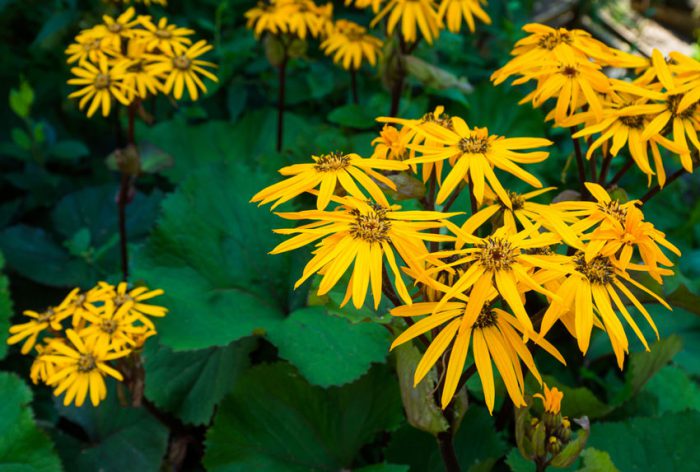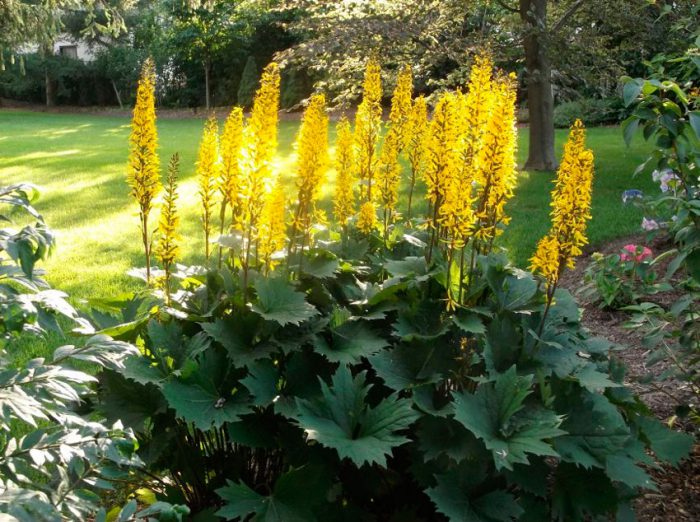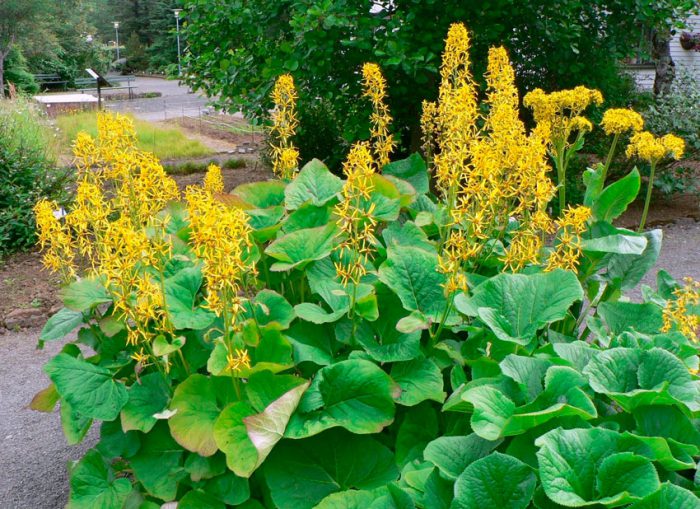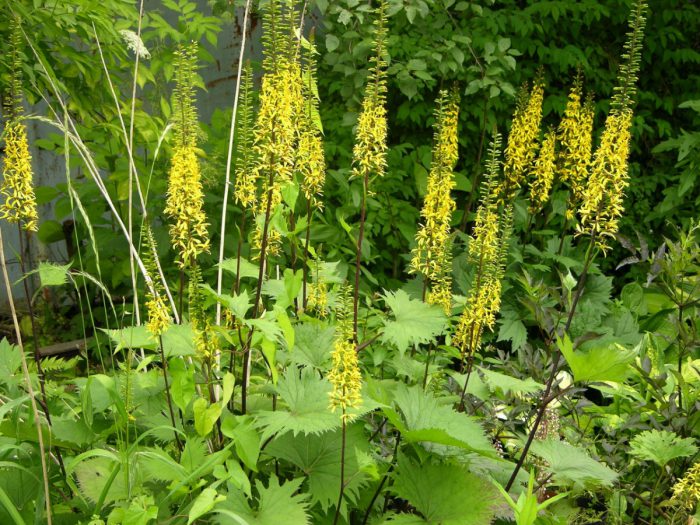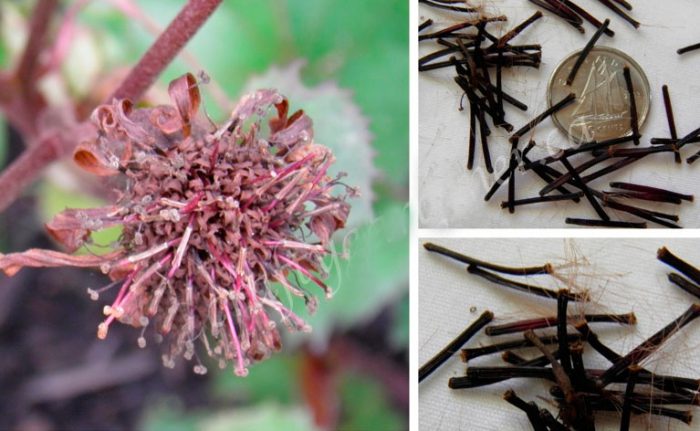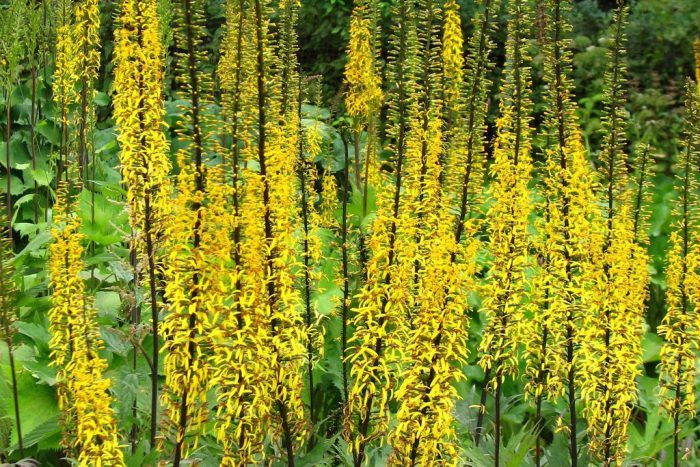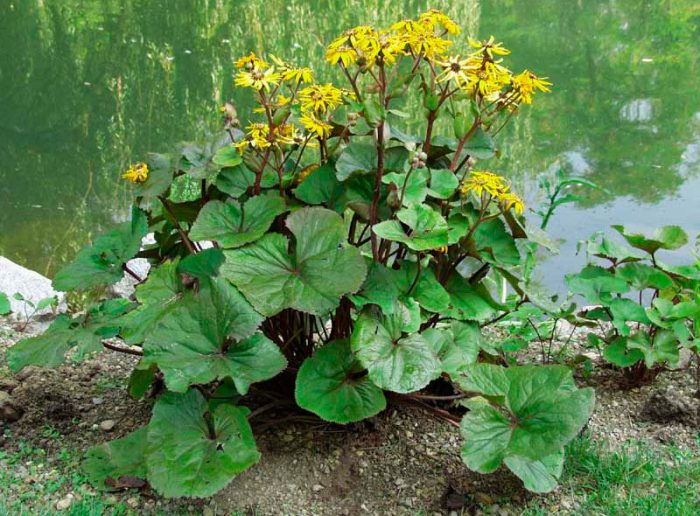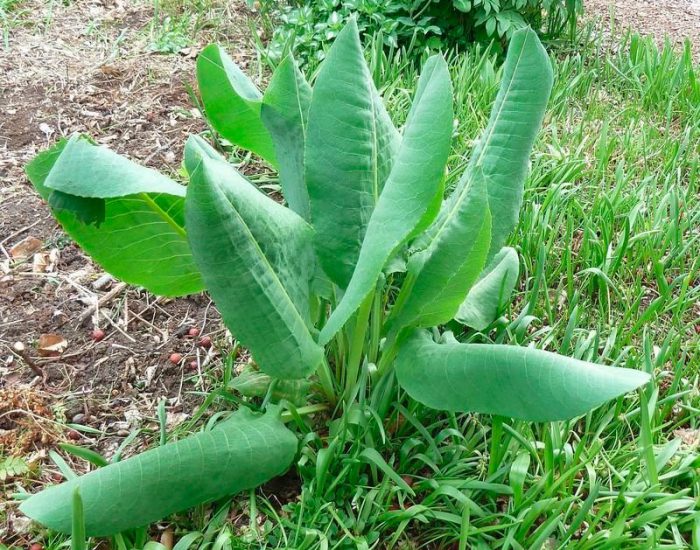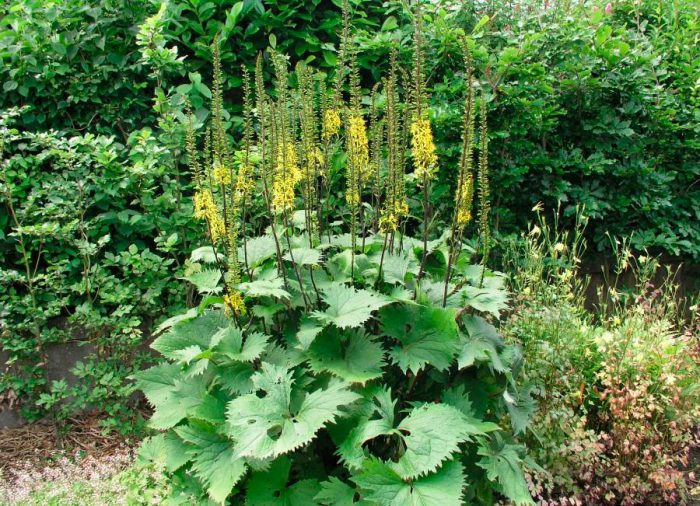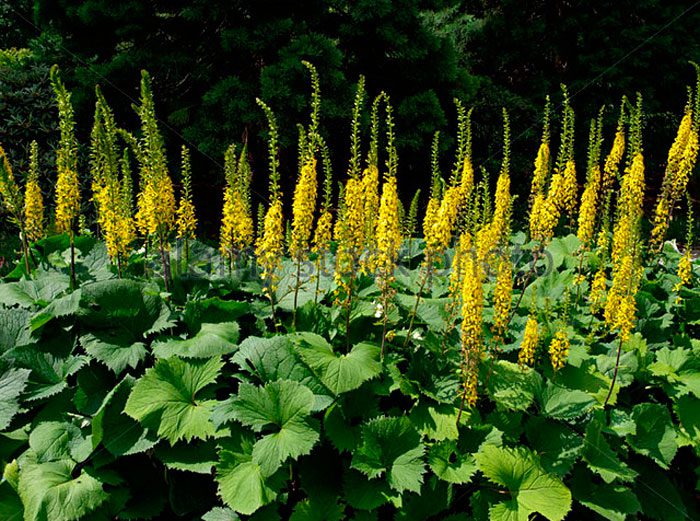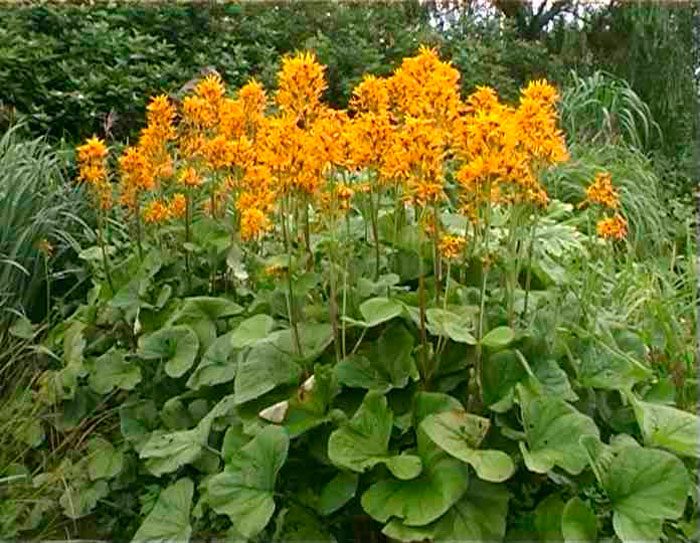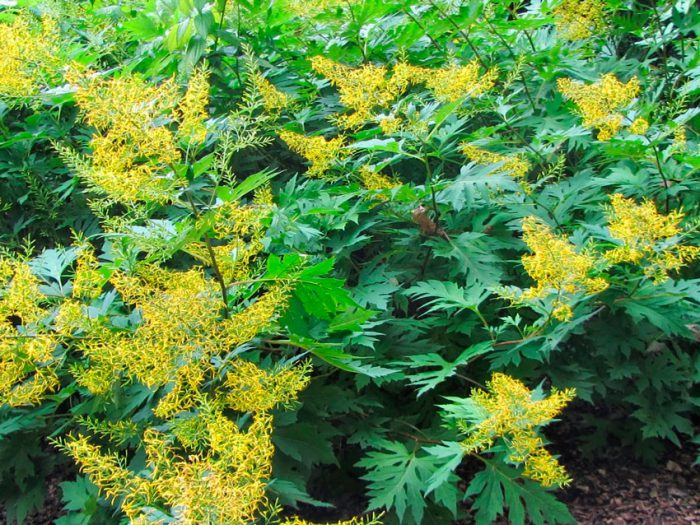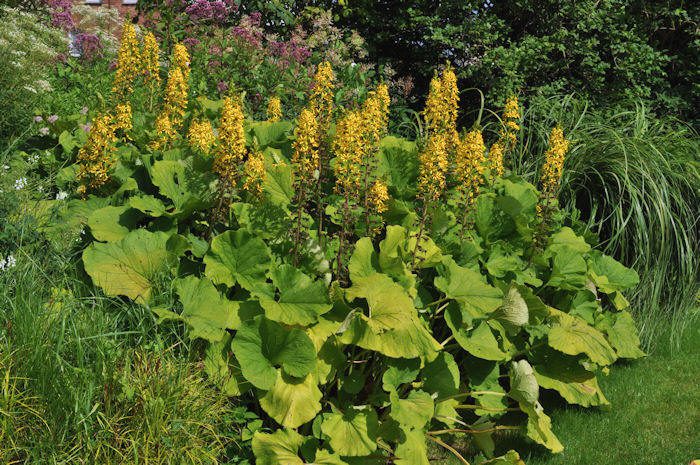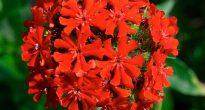Buzulnik (Ligularia) is also called ligularia. It is directly related to the genus of herbaceous perennial plants of the family Asteraceae or Asteraceae. This genus unites more than 150 species of various plants. Ligularia (ligularia) from Latin is translated as "tongue", it refers to the shape of the marginal flowers of the plant. In natural conditions, such plants can be found in Europe and Asia. In recent years, the buzulnik has become increasingly popular with gardeners, while this plant displaces such gardeners as peonies and phlox. They are shade-loving, bloom for more than eight weeks and can go without transplant for many years.
Content
- 1 Features of Buzulnik
- 2 Planting a buzulnik
- 3 Care features
- 4 Buzulnik after flowering
- 5 The main types and varieties with photos and names
- 5.1 Buzulnik Przewalski (Ligularia przewalskii)
- 5.2 Buzulnik toothed (Ligularia dentata)
- 5.3 Buzulnik Kempfer (Ligularia kaempferi)
- 5.4 Large-leaved Buzulnik (Ligularia macrophylla)
- 5.5 Wilson Buzulnik (Ligularia wilsoniana)
- 5.6 Siberian Buzulnik (Ligularia sibirica)
- 5.7 Narrow-leaved Buzulnik (Ligularia stenocephala)
- 5.8 Fisher's Buzulnik (Ligularia fischeri)
- 5.9 Buzulnik Hessei (Ligularia x hessei)
- 5.10 Buzulnik Tangut (Ligularia tangutica), or Tangut rosewort
- 5.11 Buzulnik Vicha (Ligularia veitchiana)
- 5.12 Buzulnik palchatolobastny, or palmate (Ligularia x palmatiloba)
- 5.13 Buzulnik Vorobiev (Ligularia vorobievii)
Features of Buzulnik
The height of the buzulnik can reach 1.2 meters. The stems are straight, and on them there are large (up to 60 centimeters in diameter) long-petiolate leaf plates of a triangular or heart-shaped shape. They can be purple-green, green, or greenish-purple. There are species in which the front side of the leaves is greenish-purple, and the back is purple. It happens that the leaf itself is colored green, and its veins and petioles are purple or light red. Inflorescences-baskets in diameter can reach 10 centimeters, they consist of many tubular unattractive flowers, but the marginal flowers are quite spectacular and can be colored orange, deep yellow or light red. Such baskets are part of inflorescences that have a spike-shaped, paniculate, racemose or corymbose shape. Peduncle height can be up to 200 centimeters. Flowers in inflorescences open from bottom to top. Flowering begins in the second half of June and ends in mid-August or later. The fruit is a crested achene.
Planting a buzulnik
Sowing seeds
Buzulnik can be propagated by dividing the bush and seeds.Sowing of seeds is carried out in the spring in open ground, while they are buried only 1 centimeter. Before seedlings appear, it is necessary to ensure that the soil is always moist. Shown seedlings must be shaded from direct sunlight from lunch to evening. However, it is recommended to sow in November or December before winter, and use recently collected seeds for this, during the winter they can undergo natural stratification. For seedlings, seeds are sown in January or March (depending on the flowering time of the variety or species), they are transplanted into open soil in May, when there is no threat of frost. In the event that the seeds have time to ripen directly on the bush and fall on the soil surface, then self-seeding occurs. A plant grown from a seed begins to bloom only at the age of 4 or 5 years.
Transplanting and dividing the buzulnik bush
In the same place, this plant can grow for about 20 years. However, once every 5 years, the bush must be dug up, divided and transplanted, since the root system grows strongly and protrudes from under the soil. The best time for transplanting is spring, at the beginning of the growing season, at a time when young leaf plates are just beginning to grow, since it is at this time that the delenki will take root faster and best. The whole bush should not be dug out of the ground; you need to cut off the necessary part with a shovel and dig only it. The resulting hole must be filled with nutrient-rich soil, then water the remaining bush. The dug out part of the plant must be thoroughly washed, and then, using a very sharp knife, divide it into divisions. At the same time, at least one viable kidney must be present on each section. Places of cuts must be treated with crushed charcoal or potassium manganese solution. The planting hole should be 40x40 centimeters in size, while the distance between plants should be from 100 to 150 centimeters. Before planting, pour 1.5 buckets of humus into the hole, as well as a small amount of superphosphate and wood ash. Correctly planted divisions for the next year are already very beautiful.
Emergency landing
In the event that you are going to plant a flowering plant during the summer, then the bush must be prepared. To do this, you need to remove the peduncle and cut off 1/3 of the leaves, while you need to start from the lower leaf plates. It should be planted in the same way as delenki (see above). The bush should be protected from direct sunlight, and also make sure that the soil is damp all the time. Since you will be replanting the buzulnik in the summer, it will take a lot of strength from it until it takes root. After about 4 weeks, it should completely take root.
Care features
For planting, you should choose a shaded place, while the soil should be moist, rich in humus and nutrients. A site near a natural or artificial reservoir is best suited. After the growing season of the buzulnik begins in the spring, it will be necessary to loosen the soil and sprinkle it with a layer of mulch. In the summer, you need to systematically water the plant during the drought period, and if the need arises, then tie up the inflorescences. The longer the flower is under the scorching rays of the sun, the more frequent watering it will need. Top dressing should be done from the end of the spring period to July, for this use mullein infusion in a ratio of 1:10. In the autumn, it is recommended to add humus to the soil by ½ part of a bucket under the bush, but try not to get fertilizer on the root system.
Diseases and pests
Buzulnik is highly resistant to diseases and harmful insects. However, in springtime, the bushes can be invaded by slugs; in order to avoid this, it is necessary to cover the soil surface near the plant with granular superphosphate. In rare cases, such a flower gets sick with powdery mildew.Such a fungal disease can be eliminated by spraying the bush with a solution of colloidal sulfur (1%) or manganese potassium (2.5 g of substance per bucket of water).
Buzulnik after flowering
Seed collection
In order to collect the seeds after flowering is over, you need to select several inflorescences and tie a gauze bag to them in order to prevent self-seeding. The remaining peduncles must be removed. This helps to stimulate the growth of leaf plates, and you can also prevent unwanted self-seeding. In autumn, the leaves of the plant turn into a different spectacular color, and they decorate the garden until the second half of October. After the inflorescences are ripe, they must be carefully cut off, and already in the room, shake out the seeds, which should be winded to clear of debris. In the event that you want to sow in the autumn, then the seeds should be poured onto the surface of a paper sheet and wait for a suitable day for sowing. Before placing the seeds in a paper bag for storage, they must be completely dried.
Wintering
After the first strong frosts begin, it will be necessary to completely cut off part of the bushes located above the soil surface. After that, the area must be sprinkled with a layer of mulch. Despite the fact that this plant is frost-resistant, severe frost with a thin snow cover can harm the buzulnik.
The main types and varieties with photos and names
The types and varieties that are most popular with gardeners will be described below.
Buzulnik Przewalski (Ligularia przewalskii)
Such a plant is undemanding and unpretentious. It is often used to decorate those areas of the garden that do not look very pretty. The bush reaches a height of 150 centimeters, it has spike-shaped inflorescences and cut leaf plates (similar to maple). Such a flower, despite its monumentality, looks very graceful. Flowering begins in the last days of July.
Varieties:
- Rocket. The height of the peduncles, which are directed upward, reaches 200 centimeters. They have a huge number of yellow baskets-inflorescences. The brownish red shoots are very strong and do not need support. The leaf plates are practically round, heart-shaped, with a sharp-serrated edge. In the summer, the leaves are green, and in the autumn - crimson-burgundy.
- Maple-leaved. The leaf plates are maple-shaped. They are very large (larger than the Rocket), their diameter is about 25 centimeters. The bush can reach a height of 1.7 m.
Buzulnik toothed (Ligularia dentata)
Such a perennial plant reaches a height of about 100 centimeters. Large kidney-shaped leaf plates are part of the root rosette. The diameter of the baskets is about 7-8 centimeters, and they are part of the panicle inflorescences. The reed flowers are pale yellow, and the tubular flowers are pale brown. Flowering begins in August. The plant has moderate frost resistance, if the winter is harsh, then it will need shelter.
Varieties:
- Desdemona. The flowers are deep yellow, and the leaf plates are brownish-purple and have a jagged edge. Flowering begins in August.
- Othello. Glossy green leaf plates can be up to 50 centimeters across. From the seamy side, they are painted in a deep burgundy color. Flowers of orange-tangerine color are part of the inflorescences, the diameter of which reaches 13 centimeters.
- Osiris Fantasy. A dwarf variety that does not exceed half a meter in height. The front side of the leaves is dark green, and the wrong side is burgundy. Flowering begins in July.
Gardeners also decorate their gardens with the views described below.
Buzulnik Kempfer (Ligularia kaempferi)
This is a Japanese look. Straight shoots are slightly branched. Large kidney-shaped basal leaf plates are almost round, unevenly serrated, green in color. Their diameter can be up to 25 centimeters. There is pubescence on the surface of the petioles. There are a large number of pale yellow baskets, up to 5 centimeters in diameter. They are part of the corymbose erect inflorescences, which are located on branched peduncles.Flowering begins in July. In autumn, the area with this plant must be covered with a layer of mulch. There is an early flowering variety. Its flowers are colored golden, and the angular-rounded leaf plates are rich green. On the leaves there is a speck of golden color.
Large-leaved Buzulnik (Ligularia macrophylla)
Under natural conditions, it can be found in Central Asia and the Far East. The length of the basal lower long-petiolate leaf plates is from 30 to 45 centimeters. They have an elliptical shape and a bluish color. A large number of yellow baskets-inflorescences are part of the racemose panicle. The height of the peduncles is up to 150 centimeters. In winter, it does not need shelter.
Wilson Buzulnik (Ligularia wilsoniana)
Slightly branched straight shoots in height can reach 150 centimeters. Large reniform long-petiolate leaf plates are basal. Erect inflorescences consist of a large number of small (diameter about 25 mm) yellow baskets. Flowering begins in July. The plant is winter hardy, but it needs shelter in the winter.
Siberian Buzulnik (Ligularia sibirica)
The height of such a rhizome perennial plant can vary from 0.3 to 1.3 m. Shoots are furrowed. Rosette leaf plates can be heart-shaped-elongated, kidney-shaped or heart-triangular in shape. The racemose inflorescence includes yellow baskets.
Narrow-leaved Buzulnik (Ligularia stenocephala)
The species is very similar to the Przewalski's buzulnik. However, its flowers are larger, and the heart-shaped leaf plates are sharp-serrated.
Fisher's Buzulnik (Ligularia fischeri)
The height of a perennial plant can vary from 0.3 to 1.5 m. Rhizome is shortened, straight shoots are furrowed. Rosette leaf plates can be heart-shaped or spear-shaped. They are 12–23 centimeters long and 10–25 centimeters wide. The top of the leaves can be rounded or pointed, and they have long, thin petioles. Flowers of a deep yellow color. The racemose inflorescences consist of 2–4 baskets, the diameter of which varies from 25 to 40 mm. Flowering begins in the last days of June.
Buzulnik Hessei (Ligularia x hessei)
This is a hybrid plant created by crossing the toothed Buzulnik and Wilson. It has many similarities with toothed buzulnik, for example, the baskets are collected in a large shield, but the inflorescences are not so dense. The diameter of the baskets is 5 centimeters, outwardly they are similar to chamomile. The leaf plates are triangular-heart-shaped. The height of the bush is about 200 centimeters and 100 centimeters across. Flowering occurs at the end of the summer period.
Buzulnik Tangut (Ligularia tangutica), or Tangut rosewort
This beautiful plant has a tuberous root that forms stolons. It can be propagated very simply by dividing the rhizome, self-seeding of this species is unlikely. The height of unbranched shoots varies from 0.7 to 0.9 m. Lacy leaf plates are deeply dissected and pinnate. Elongated inflorescences consist of small yellow flowers. Bloom is observed in July and August.
Buzulnik Vicha (Ligularia veitchiana)
The height of such a perennial plant is about 200 centimeters. The length of the heart-shaped leaf plates is up to 40 centimeters. Spike-shaped inflorescences consist of many yellow baskets. Flowering begins in August. Winter-resistant, but needs shelter for the winter.
Buzulnik palchatolobastny, or palmate (Ligularia x palmatiloba)
The height of the bush is about 180 centimeters, and the diameter is 100 centimeters. Large lower leaf plates are rounded and have deep lobes. Yellow baskets are part of loose racemose inflorescences. It begins to bloom in July or August.
Buzulnik Vorobiev (Ligularia vorobievii)
The height of large bushes is about 200 centimeters, and their diameter is 120 centimeters. Dense, leathery, rounded leaf plates are dark green in color. Large baskets are part of the brushes. Flowering begins in August.
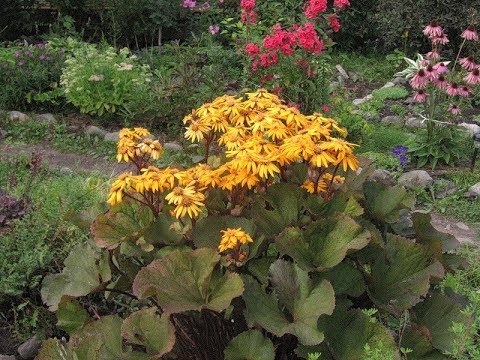

Watch this video on YouTube

